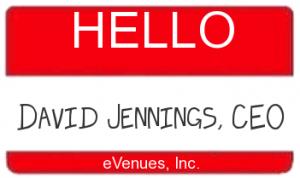More than a Name-tag: Personalizing Your Event
0 Comments
- Posted in:
- General
- Meeting Tips
 Personalization is in. In 2014, Coca-Cola took the 250 most popular names in the United States and put one at random on individual cans and bottles of their product. According to The Wall Street Journal, this campaign was responsible for reversing a decade long decline in US Coke consumption.
Put simply, people like to know it’s all about them. But how do you use personalization to your advantage when you’re planning your meeting?
Tagging It
Take a look at the ubiquitous name-tag. Obviously, you want to provide a pre-printed name-tag for all your registered meeting attendees. And surely, we do not need to remind everyone that the name-tag and all other materials should be in a clear font (put away the script and Old English fonts for another time) and in a type size that does not require binoculars to read.
But what name goes on the tag? Take Josiah Pickford Wellington III, who just happens to go by “Trey.†Do you put his legal name on his name-tag? All his friends and business associates knew him as Trey. Regardless of what name he used on his registration paperwork, which name should appear on his pre-printed name-tag? And shouldn’t he, and not the clerical person preparing the name-tags, be the one who chooses what he’s called?
And what else goes on the name-tag? With some planning from the registration materials, you could determine what the attendee would like to publicize. For example, would he like his email address to be visible? His Twitter handle? The name of the product he is promoting? Or, at the cat fanciers’ convention, a picture of his beloved, pure-bred Persian cat? If you can add information that makes the attendee feel more connected at the conference, isn’t it worth it to you to go that extra mile to discover and share these details?
More Sophisticated Identifiers
Don’t forget the other personalization options you might want to make available at the conference itself. At an extended family reunion, perhaps stickers might be available to identify what state the attendee hails from, or a badge might identify what line of the family tree she is descended from. This would create an instant place to start conversations as the participant meets far-flung relatives. At a large company meeting, perhaps a ribbon identifies whether the participant specializes in the manufacturing side or the sales side of the business. This would allow similarly affiliated attendees to easily find people who share their interests.
Strategically Designing Your Event
There are more ways to personalize an event experience beyond customizing identifiers. For instance:
Personalization is in. In 2014, Coca-Cola took the 250 most popular names in the United States and put one at random on individual cans and bottles of their product. According to The Wall Street Journal, this campaign was responsible for reversing a decade long decline in US Coke consumption.
Put simply, people like to know it’s all about them. But how do you use personalization to your advantage when you’re planning your meeting?
Tagging It
Take a look at the ubiquitous name-tag. Obviously, you want to provide a pre-printed name-tag for all your registered meeting attendees. And surely, we do not need to remind everyone that the name-tag and all other materials should be in a clear font (put away the script and Old English fonts for another time) and in a type size that does not require binoculars to read.
But what name goes on the tag? Take Josiah Pickford Wellington III, who just happens to go by “Trey.†Do you put his legal name on his name-tag? All his friends and business associates knew him as Trey. Regardless of what name he used on his registration paperwork, which name should appear on his pre-printed name-tag? And shouldn’t he, and not the clerical person preparing the name-tags, be the one who chooses what he’s called?
And what else goes on the name-tag? With some planning from the registration materials, you could determine what the attendee would like to publicize. For example, would he like his email address to be visible? His Twitter handle? The name of the product he is promoting? Or, at the cat fanciers’ convention, a picture of his beloved, pure-bred Persian cat? If you can add information that makes the attendee feel more connected at the conference, isn’t it worth it to you to go that extra mile to discover and share these details?
More Sophisticated Identifiers
Don’t forget the other personalization options you might want to make available at the conference itself. At an extended family reunion, perhaps stickers might be available to identify what state the attendee hails from, or a badge might identify what line of the family tree she is descended from. This would create an instant place to start conversations as the participant meets far-flung relatives. At a large company meeting, perhaps a ribbon identifies whether the participant specializes in the manufacturing side or the sales side of the business. This would allow similarly affiliated attendees to easily find people who share their interests.
Strategically Designing Your Event
There are more ways to personalize an event experience beyond customizing identifiers. For instance:
- - Create custom Twitter or RSS feeds for each person or similar group of attendees
- - Create a personalized agenda for each attendee that is built on that person’s personal or professional interests
- - Use apps like Guidebook or Double-dutch that allow attendees to manage their own schedules efficiently and securely